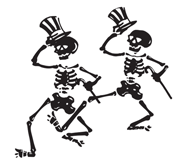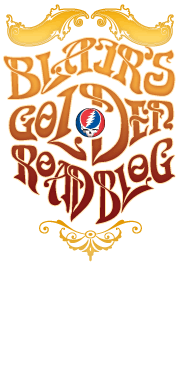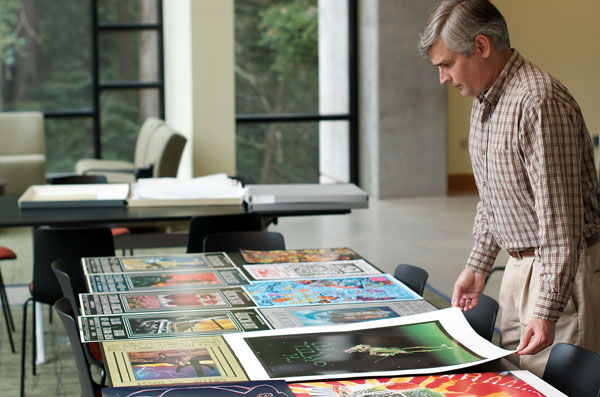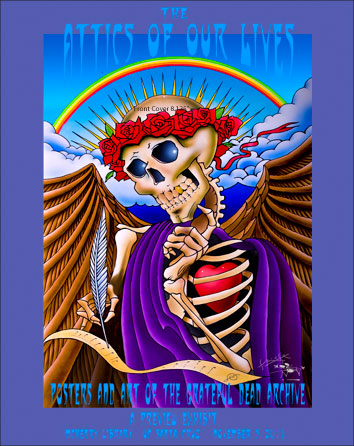It was nearly four years ago—April 24, 2008, to be precise—that the Grateful Dead announced at a press conference at the Fillmore in SF that the group was donating its archives and assorted memorabilia to the University of California at Santa Cruz and would reside in that sylvan campus’ McHenry Library. There was chatter about making much of what was in the archives available on the Internet and also creating an exhibition space in the McHenry Library called Dead Central, where the band could show off some of the collectibles they accumulated over their 30-year history, much of it saved by Eileen Law, who was the group’s primary liaison with Dead Heads beginning in 1972.
At the time, UCSC’s head of special collections for the library, Christine Bunting, told the SF Chronicle, “I think it’s a perfect fit for Santa Cruz—the ethos of the band, the whole idea of community sharing, is really well matched with our campus. [UCSC] has a great music program, and we’re really interested in the study of American vernacular music and popular culture. We also have this whole side that’s concerned with social justice and tolerance and community spirit. And I think that fits so perfectly with what the band and what the Dead Heads have sustained over the years.”
Not long after that, the Dead’s archives—more than 500 boxes’ worth—were trucked down to Santa Cruz and loaded into a warren of rooms in the bowels of McHenry Library, and the arduous task of organizing and processing the incredible range of material—everything from press clippings to financial records to thousands of decorated envelopes sent in to GDTS (Grateful Dead Ticket Sales) to posters and much more—began. Meanwhile, McHenry Library underwent serious renovation that stretched over a couple of years and turned the modern building tucked amid the redwoods into a construction zone.
The next major step in the archive’s evolution occurred in the spring of 2010 when, after a nationwide search, Nicholas Meriwether was hired to be the Grateful Dead archivist at UCSC; a terrific choice! Nick’s academic CV was certainly impressive — a degree in history from Princeton, a sojourn at Cambridge, and a master’s degree in Library Science from the University of South Carolina (his home state). But his Dead Head credentials are every bit as strong. He contributed a definitive scholarly look at the Acid Tests for The Deadheads’ Taping Compendium, Vol. I, and was also editor of All Graceful Instruments: The Contexts of the Grateful Dead Phenomenon (Cambridge Scholars Press, 2007), and four volumes of Dead Letters: Essays on the Grateful Dead Phenomenon (Dead Letters Press). This is a guy who has dug deep into many aspects of the Dead’s history and Dead Head culture, and he knows the players involved and understands how he can expand the Archive’s collection in year’s to come. Indeed, he has already landed several other important bequests of Grateful Dead-related materials for the Archive, including collections from Grateful Dead historian Dennis McNally, photographer Susana Millman and former GD employee Steve Brown, with several more pending.
The big news, however, is that the Grateful Dead archive will have its formal opening this spring at McHenry. There will be a celebratory free party and also the debut exhibit in the Archive’s custom 1,400-square-foot space off the beautiful new atrium lobby. A couple of hundred people got a sneak preview of that then-unfinished space on Nov. 5 of last year, when the university hosted a fundraiser for the Archive in the psychedelically redecorated atrium. As a band consisting of members of a couple of Santa Cruz Dead cover bands played sparkling instrumental versions of GD favorites, guests noshed on a variety of fine food offerings from a central buffet and had the opportunity to mingle with the likes of Stanley Mouse, Rock Scully, Trixie Garcia, Dennis McNally and other “family” types. Best of all, though, was the fantastic one-night-only exhibit put together by Nick Meriwether for the occasion, called “The Attics of Our Lives: Posters and the Art of the Grateful Dead Archive.” As the title implies, it was filled with colorful art inspired by the Dead’s history, but also showcased handwritten lyrics by Robert Hunter (such as the original “He’s Gone,” complete with cross-outs), photos, fan envelopes and more. Nick also put together a gorgeous 223-page, full-color hardcover book that was given out to each attendee at the benefit. It contains dozens of reproductions of posters and artwork from the Archive, a detailed essay about the exhibit, interviews with Stanley Mouse (who designed the book cover and exhibit poster) and more. It was quite an evening and a bright foreshadowing of things to come from the GD Archive. Stay tuned for details about the grand opening celebrations!
A couple of weeks ago, I spoke with Nick Meriwether about the Archive and the upcoming events.
I would guess that the Grateful Dead Archive was not your typical archive bequest, right?
Of course not! You’re dealing with an archive that was always a community undertaking. Normally, archival practice is focused on a records-management mentality, where everyone from Joe’s Hardware Store to Exxon Corporation would have had a record-keeping system that made sense and was useful to them for the course of that business, and then at the end of that business’ life or at the end of the records’ life, they would turn that over to an archive and the archive wouldn’t usually have to do that much work in order to make it accessible and comprehensible to researchers.
With the world of the Grateful Dead, that never happened. They were a working rock band and they didn’t organize their records like a regular corporation might, even though, of course, they were a corporation. They also never had a full-time records manager. Eileen Law and a bunch of the people in the office were very, very good archivists. But, for example, when Dennis McNally was working on his book [A Long Strange Trip], when Paul Grushkin was working on the Book of the Dead Heads, when any passing journalist—like you when you were editing The Golden Road—needed materials, those materials would be made available to you, and they might or might not get back to their original place in the archive. To compound all this, often when employees left, they sometimes took with them the records that they had been most responsible for, because often when they left, they had ongoing businesses they had to wrap up. It all made sense to work that way back then, but from my standpoint, what I have now is a fascinating skeleton of an incredible collection. So that’s why I’m going around and talking to everyone from [GD ticket czar] Steve Marcus to Steve Brown to Eileen Law to Cassidy Law [Eileen’s daughter, who worked in the office in the later days] to [late ’80s and ’90s manager] Cameron Sears, to find out who’s got what, who can fill which holes.
This makes my life, on the one hand, very complex and occasionally maddening and frustrating, on the other absolutely wonderful and marvelous—because isn’t this cool that everyone who was involved with this phenomenon and this organization realized that no matter what the difficulties, no matter what some of the more difficult personalities may have been, their involvement was such a luminous, magical thing that they all entertain very good will towards their involvement with that and have been incredibly supportive and generous whenever I’ve approached them.
There are many more pockets of records that we’re looking into, but it’s a difficult process because right now, because the Archive has no money for acquisitions, so all I can really offer people right now is: “Hey, don’t you want your place in this history to be enshrined? Well, this is the best way to do it.”
How will the public be able to participate in the Archive? There was talk about putting materials online, for instance…
There’s going to be a whole series of things that are going to happen, and the proper way to look at this is that like any big, complex archive, the work is going to continue for many, many years. It’s a huge job to even process that first bequest. We get additional collections every week, and we’re getting, I hope very soon, a substantial infusion of original materials that may end up being as large, or larger, than the first bequest.
The original gift was split into 10 separate sections. Each one of those sections—like photographs, like press—is being processed separately. As each is processed, it will be made available to researchers, and we’re digitizing as much of that as we can to make it available for everyone to look at on the Web. We anticipate the first couple of series being made available to researchers some time in April. We anticipate additional series coming online over the course of the summer and in the fall. But it’s going to take a few years, most likely, to get it all done. And that’s also true for a lot of supporting collections.
The “Attics of Our Lives” exhibit at the party was really impressive. What’s your plan for that space once it opens officially? The plan right now is to have probably two full-fledged exhibits per year. That will be determined in part by the funding we can engender. Our first exhibit will go up in April. We plan on having a big public party to inaugurate the Archive—that will be sometime in May and be free; probably with some live Dead music being played; no, not by any of the Dead. [Laughs] I’ll lead guided tours of the exhibit. The exhibit space is almost done in terms of the planning, and we’ve started construction on it. What you saw there on Nov. 5 was just a temporary shell for the space.
The first exhibit is going to be called “A Box of Rain: Archiving the Grateful Dead Phenomenon,” and that’s going to be an overview of the Archive itself, as a way of explaining what the Grateful Dead and the Grateful Dead phenomenon were and are. It’s going have a wonderful poster and, I hope, a catalog of the exhibit.
There are basically three different kinds of exhibits I want to have in that space. This kind of exhibit—and we’ll probably have to do one these every three or four years as new material keeps coming in—is sort of a smorgasbord, where you say, “Look at the cool stuff we’ve gotten,” and explain how it fleshes out the picture. A second category is going to be more historically themed exhibits. I think the one I’d like to do second—and it may not be second, but it will happen soon—would be the birth of the Grateful Dead from the Acid Tests through the Summer of Love. It fits the 1,400 square foot exhibit space beautifully, and it’s cool. So much of what made the Grateful Dead the Grateful Dead happened in those first three magical years. I think a third exhibit might be a specifically themed exhibit, and this could be everything from the sound systems and technological innovations of the Grateful Dead, to maybe something on the women in the Grateful Dead scene, to the parking lots … It’s almost endless on what we can do.
* * *Want to learn more about the Grateful Dead Archive? Check out the website.








